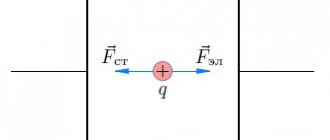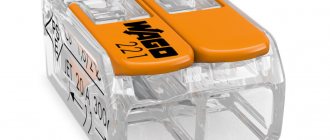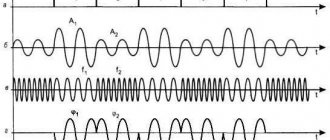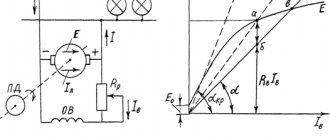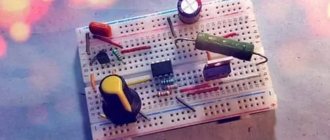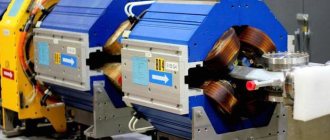CURRENT SOURCES, devices that convert various types of energy into electrical energy. Based on the type of energy converted, energy sources are conventionally divided into chemical and physical. The first information about the chemical Electrical batteries (galvanic cells and batteries) date back to the 19th century. (e.g. volt column, 1800; Daniel-Jacobi cell, 1836; lead battery, 1859). Until the 1940s Only a few have been developed and put into practice in the world. types galvanic elements and batteries; Subsequently, in connection with the development of radio electronics and the widespread use of autonomous power supplies, their production continuously expanded. Portable illumination. devices, tape recorders and radios, televisions and portable medical equipment. equipment, vehicles, aircraft and spacecraft. devices and much more are equipped with small-sized electrical generators. The first electric machine generator of direct current was created by B. S. Jacobi in 1842. Since the 1920s. as an industrial Turbogenerators and hydrogenerators began to be used as sources of electricity. Phys. Electrical technologies based on other principles (thermoelectric generators, thermionic converters, solar batteries, etc.) were developed and developed in the 2nd half. 20th century, which is due to the increased demands of modern times. technology.
The most important characteristics of electric power include: efficiency, energy intensity (or specific energy intensity), power (or specific power per unit mass or volume), service life, quality of generated electricity (frequency, voltage, overload capacity, cost, reliability ).
Sources of direct electric current
There are several main types of DC energy sources. Each of them is based on the use of different physical principles and is used in specific conditions. These include the following types:
- mechanical, converting the mechanical energy of rotor rotation into electrical energy;
- thermal, in which thermal energy is converted into electrical energy;
- chemical, in which the energy released as a result of a chemical process is converted into electrical energy;
- light, converting the energy of sunlight into electrical energy.
Electricity is mainly generated by power plants, from which consumers receive not direct current, but alternating current, which is then converted to direct current. But in many areas, only thermal, light or chemical sources of direct electric current can be used.
Electric batteries
This is a reusable DC source that does not operate continuously, but until the next charge. Based on their chemical nature, they are divided into types:
- lead-acid;
- lithium-ion (lithium);
- nickel-cadmium;
- nickel-iron.
Lead-acid models are used in automobiles, uninterruptible power supplies, transport, industry, communications and telecommunications.
Lithium-ion batteries are widely used in mobile communications, power tools, telecommunications systems, as well as autonomous and emergency power supplies. Here is just a small list of the range of their compositions:
- lithium titanate;
- thionyl chloride;
- lithium cobalt;
- lithium manganese;
- lithium iron phosphate;
- lithium polymer;
- lithium sulfur dioxide;
- lithium manganese dioxide.
Lithium-ion power sources
Interesting. Nickel-cadmium alkaline batteries are used in aviation, river and sea navigation, and in electric cars.
Nickel-cadmium batteries
Nickel-iron alkaline is a very reliable type of source. Deep discharges and frequent undercharging, which are detrimental to lead-acid batteries, do not damage them. They are used in traction transport circuits and backup power circuits.
Traction nickel-iron battery
Heat sources
These sources use the thermoelectric effect. Electric current in a closed circuit arises due to the temperature difference between metals or semiconductor structures in contact with each other. At the point of contact, when heated, an electromotive force (thermo-EMF) arises. The electric current of charged particles is directed from the heated area towards the cold one. Its value is proportional to the temperature difference. A thermocouple is formed at the junction.
Devices that use heat released during the decay of radioactive isotope materials to create direct current are radioisotope thermoelectric generators.
Operating principle
Each marking of current sources determines the principle of its operation. In a standard situation, energy is generated through the interaction of component parts, namely:
- Mechanical type. As a result of the interaction of mechanism parts, friction occurs. Due to this phenomenon, static electricity arises and is converted into current.
- Mechanical structures work by producing sequentially moving charged particles. The phenomenon occurs due to the interaction of a chemical element with an electrolyte. Charged particles leave the structure of the metal crystal lattice, becoming part of the conducting liquid.
- Solar batteries (light sources) work by knocking out charged particles from a dielectric (silicon) base under the influence of a light flux. This creates constant tension.
- Thermal. As a rule, these are 2 metal bases connected in series. One part heats up, while the other remains cooled. When the temperature regime changes, a temperature difference occurs, resulting in the movement of charged particles.
You might be interested in Finding out the cathode and anode
Important! Any change in the structure of a substance can lead to irreversible consequences that will manifest themselves during the operation of the device.
Light sources
The property of semiconductors to create an emf when a light stream hits them is used in the creation of direct current light sources.
Combining a large number of silicon structures makes it possible to create solar cells. Small power plants created on the basis of such solar panels currently have an efficiency of no more than 15%.
Measuring instruments
If you have measuring instruments at hand, then using them it is quite easy to find the current strength. You just need to follow the measurement rules and not forget about the safety rules.
Ammeter
When using instruments for measuring amperage, you should remember that they are connected in series in the circuit. The internal resistance of the ammeter is very small, so the device is easily damaged if measurements are taken outside the values for which it is designed.
The ammeter connection diagram is shown in Figure 3. Please note that there must be a load in the section of the electrical circuit being measured.
Rice. 3. Ammeter connection diagram
Most analog ammeters, such as those in Figure 4, are designed for measuring parameters in circuits with direct currents.
Rice. 4. Analog ammeter
Note the distribution of the ammeter scale. The value of the first division is 50 A, and all subsequent divisions are 10 A. The maximum value that can be measured with this ammeter should not exceed 300 A. To measure electrical quantities in smaller or larger limits, appropriate instruments designed for such ranges should be used. In this sense, the ammeter's versatility is limited.
When measuring direct currents, it is necessary to observe the polarity of the probes when connecting the ammeter. To connect the device you need to break the circuit. This is not always convenient. Sometimes calculating the current using a formula is preferable, especially if you have to take measurements in complex electrical circuits.
Multimeter
The advantage of a multimeter is that this device is multifunctional. Modern digital multimeters. They have modes for measurements in direct and alternating current circuits. In current measurement mode, this measuring device is connected to the circuit in the same way as an ammeter.
Before connecting the multimeter to the circuit, always check the measurement mode, and select measurement limits that are obviously larger than the expected current strength. After the first measurement, you can switch to a mode with a smaller range.
To work with alternating voltage, switch the device to the appropriate mode. Read the values from the display after the numbers stop flashing.
Chemical sources
The production of positive and negatively charged particles in chemical direct current sources is carried out through chemical reactions. According to the classification of chemical sources, they are divided into 3 groups:
- galvanic cells, which are primary sources;
- electric rechargeable batteries (AB), or secondary HIT;
*HIT - chemical current sources.
Galvanic cells use a principle of operation based on the interaction of two metals through an electrolyte medium. The type and characteristics of the CIT depend on the selected pair of metals and the composition of the electrolyte. Two metal electrodes of the current source, by analogy with a device of one-way conductivity, are called anode (“+”) and cathode (“-“).
The materials for making the anode can be lead, zinc, cadmium and others. The cathode is made of lead oxide, graphite, manganese oxide, and nickel hydroxide. Based on the composition of the electrolyte, galvanic cells are divided into 3 types:
- salt or “dry”;
- alkaline;
- lithium
In the first two types of elements, a graphite-manganese rod (cathode) is placed along the axis of a zinc cylindrical cup (anode). The free space between them is filled with a paste based on ammonium chloride (saline) or potassium hydroxide (alkaline).
In lithium cells, the zinc anode is replaced with alkaline lithium, which has led to a significant increase in operating time. The cathode material in them determines the output voltage of the battery (1.5-3.7) V. Primary CITs are single-acting sources. Its reagents, which are consumed during operation, cannot be restored.
Batteries are devices in which the electrical energy of an external current source is converted into chemical energy during charging and its accumulation. During operation (discharge), a reverse transformation occurs - chemical energy serves as a source of direct electric current.
The main types of batteries include:
- lead-acid;
- nickel-cadmium alkaline;
- lithium-ion.
To create chemical processes, a set of plates is placed in an electrolyte solution. In batteries created using modern technologies, the solution is not a liquid, but a gel composition (GEL) or honeycomb separators impregnated with electrolyte and placed between lead plates (AGM).
Lead-acid and nickel-cadmium alkaline batteries for operation as DC sources for starting automobile engines are assembled from a set of individual battery cells (“cans”). Each “can” provides a voltage of 2.1 V at its terminals. 6 elements connected in series and placed in a shock-resistant housing have the 12 V necessary for starting the engine at the battery output terminals.
In lithium-ion batteries, lithium ions serve as electric current carriers. They are formed on a cathode made of lithium salt. The anode can be made of graphite or cobalt oxides. The DC voltage at the battery output can vary between (3.0-4.2) V depending on the materials used. These batteries have a low self-discharge current and allow a large number of charge/discharge cycles. Thanks to this, all modern gadgets use batteries of this type.
Galvanic cells
These are a series of chemical power sources called batteries. The battery voltage depends on the number of units it contains and the type of metals used in it. The voltage can range from 1.5 to 4.5 volts. Metal meshes are inserted into a metal cylinder, onto which an oxidizing agent is applied by spraying. The electrolyte is an acid or potassium or sodium salt. As the reaction stops, the current in the battery decreases. The battery cannot be restored further.
Galvanic cell, operation diagram
Mechanical DC Power Sources
Devices that convert mechanical energy into electrical energy are turbo and hydro generators. They produce alternating electric current. For the majority of household appliances, the DC source is their power supply. They convert the alternating voltage of the generator into the direct voltage necessary for the operation of the devices. This task is performed by rectifiers, which must provide the necessary power of the DC source for their load and a constant output voltage value, independent of the current consumed.
Power supplies can be linear and switching. Linear blocks are made according to different schemes, the basis of which is:
- half-wave rectifiers;
- full-wave rectifiers.
Rectifiers use the property of semiconductor diodes to pass current in only one direction. The voltage rectified in this way is not yet constant. The capacitances of the smoothing filter capacitors following the rectifier, with their fast charge and slow discharge, maintain the positive unipolar voltage at a certain value. Its value is determined by the transformer receiving voltage from the alternating current generator. For a single-phase home network voltage of 220 V 50 Hz, its steel core has significant dimensions and weight.
Half-wave circuits contain only one semiconductor diode, which passes only one half-wave of a sinusoidal alternating input voltage.
Full-wave rectifiers are made using a bridge circuit or a common-point circuit. In the latter case, the secondary winding of the network transformer has a terminal from its middle. These rectifiers are a parallel connection of two half-wave rectifiers. They act on both half-waves of the alternating input voltage sinusoid.
The bridge rectifier circuit is the most common. The connection of 4 diodes in it resembles a “square”. The alternating voltage of the secondary winding of the network transformer is connected to one of the diagonals. The load is included in another diagonal of the “square”. This will be the input element of the smoothing filter.
Designation of current sources
So that when choosing there is no question as to what type of current source is presented, special designations are used. In physics, there are precise graphical representations that allow you to identify the type of source used:
Designations
On each symbol chart you can see the following parameters:
- General designation of the current source and the driving force of the EMF;
- Graphic image without EMF;
- Chemical type;
- Battery;
- Constant pressure;
- AC voltage;
- Generator.
Thanks to graphic identifiers on an electrical circuit diagram, you can always determine which type is used in a particular situation and how to correctly designate it. There are also international designations, which are found a little less frequently, usually when implementing international projects.
Source control
To ensure a constant value of the output voltage level, independent of the current consumed by the load and fluctuations in the input AC voltage, all modern DC power supplies have a stabilization and regulation stage.
In it, the output voltage is compared with a standard (reference) value.
When a difference appears between them, a control signal is generated, which changes the output voltage through the control circuit. The value of the reference voltage can be varied within wide limits, having at the output of the regulated DC power supply the voltage necessary for operation.
What are current sources
Current sources are elements of an electrical circuit that support energy with given parameters. At the same time, the energy supply of the circuit does not depend on the characteristics of the elements included in its composition, in particular, resistance.
Device for generating current
There are ideal and real devices for generating current:
- Ideal ones are determined only thanks to hypotheses and theoretical calculations. Thus, scientists often determine a number of conditions under which the current has maximum values close to ideal. That is, an imitation of an ideal source is carried out.
- Real-life conditions support the specified output current and voltage parameters. Any device ensures its operation, provided that its technical characteristics allow it to do so.
Important! Thus, the maximum value of current and voltage make it possible to determine which version of the source will be used in the circuit - ideal or real.
Pulse sources
Circuits using input network voltage transformers are called linear. In switching power supplies, double conversion is performed - first, the alternating voltage is converted into direct voltage by the rectifier, then an alternating pulse voltage of a higher frequency is generated, which is again converted into a direct voltage of the required value in the output stage.
Pulse generators produce a continuous pulse sequence with a frequency of (15-60) kHz. The output voltage is regulated by pulse width modulation (PWM), in which the signal level at the output of the power supply is determined by the width of the pulses generated by the generator and their duty cycle value. Regulated pulse-type DC power supplies are increasingly used in the creation of equipment for various purposes.
LiveInternetLiveInternet
Wednesday, November 17, 2010 22:06 + in quotation book Abstract plan 1. What is electric current. Basic concepts and terms. 2. What are sources of electric current. 3. Historical background. 4. Modern sources of electric current. 5. Chemical sources of electric current. 6. Physical sources of electric current. 7. Conclusion. 1. What is electric current. First of all, it is worth finding out what electric current is. Electric current is the ordered movement of charged particles in a conductor. For it to arise, an electric field must first be created, under the influence of which the above-mentioned charged particles will begin to move. The first knowledge of electricity, many centuries ago, related to electrical “charges” produced through friction. Already in ancient times, people knew that amber, rubbed with wool, acquired the ability to attract light objects. But only at the end of the 16th century, the English physician Gilbert studied this phenomenon in detail and found out that many other substances had exactly the same properties. Bodies that, like amber, after rubbing, can attract light objects, he called electrified. This word is derived from the Greek electron - “amber”. Currently, we say that bodies in this state have electrical charges, and the bodies themselves are called “charged.” Electric charges always arise when different substances come into close contact. If the bodies are solid, then their close contact is prevented by microscopic protrusions and irregularities that are present on their surface. By squeezing such bodies and rubbing them against each other, we bring together their surfaces, which without pressure would only touch at a few points. In some bodies, electrical charges can move freely between different parts, but in others this is impossible. In the first case, the bodies are called “conductors”, and in the second - “dielectrics, or insulators”. Conductors are all metals, aqueous solutions of salts and acids, etc. Examples of insulators are amber, quartz, ebonite and all gases found under normal conditions. Nevertheless, it should be noted that the division of bodies into conductors and dielectrics is very arbitrary. All substances conduct electricity to a greater or lesser extent. Electric charges are positive and negative. This kind of current will not last long, because the electrified body will run out of charge. For the continued existence of an electric current in a conductor, it is necessary to maintain an electric field. For these purposes, electric current sources are used. The simplest case of the occurrence of electric current is when one end of the wire is connected to an electrified body, and the other to the ground. Electrical circuits supplying current to light bulbs and electric motors did not appear until the invention of batteries, which dates back to around 1800. After this, the development of the doctrine of electricity went so quickly that in less than a century it became not just a part of physics, but formed the basis of a new electrical civilization. 1.1. Basic explanations and terms. Electrical engineering is a field of science and technology that studies electrical and magnetic phenomena and their use for practical purposes. Each science has its own terminology. Let's remember the terms and concepts of electrical engineering. An electrical circuit is a set of devices designed to produce, transmit, transform and use electric current. All electrical devices according to their purpose, principle of operation and design can be divided into three large groups. 1. Energy sources, i.e. devices that produce electric current (generators, thermoelements, photocells, chemical elements). 2. Receivers, or load, i.e. devices that consume electric current (electric motors, electric lamps, electrical mechanisms, etc.). 3. Conductors, as well as various switching equipment (switches, relays, contactors, etc.). The directed movement of electric charges is called electric current. Electric current can occur in a closed electrical circuit. An electric current, the direction and magnitude of which does not change, is called direct current and is denoted by the capital letter I. An electric current, the magnitude and direction of which does not remain constant, is called alternating current. The value of the alternating current at the considered moment in time is called instantaneous and is denoted by the lowercase letter i. For an electrical circuit to operate, it is necessary to have energy sources. In any source, due to external forces of non-electric origin, an electromotive force is created. A potential difference or voltage arises at the source terminals, under the influence of which an electric current arises in the external part of the circuit connected to the source. There are active and passive circuits, sections and elements of circuits. Active circuits are electrical circuits that contain energy sources, while passive circuits are electrical circuits that do not contain energy sources. 2. What are sources of electric current. Sources of electric current are batteries, accumulators, dynamos, various types of generators, etc. They produce electricity due to some other type of energy, for example, chemical, mechanical, thermal, etc. Consequently, in cases with sources of electric current, the law of conservation of energy remains in force. Each current source has the property, when the circuit is closed, to create an electric field in the conductors, which acts with a certain force on free electrons. Therefore, they say that each current source has a certain electromotive force (EMF). Sources of electric current do not produce electrons, but the electric field they create sets in motion free electrons located in the conductors themselves. In this respect, any current source can be compared to a pump that moves water in a closed pipe system. The pump transfers energy to the turbine in the same way that a battery transfers energy to a light bulb. Obviously, in any unbranched system, the amount of water flowing in thick and thin pipes per unit time is the same. Only through thin pipes do water particles move at higher speeds. By analogy, we can say that the magnitude of the current in an unbranched electrical circuit is the same everywhere, only in conductors of larger diameter the electrons move more slowly than in thinner conductors. Electrical energy can be obtained by converting chemical energy (in galvanic cells and batteries), converting the thermal energy of coal (thermal power plants), converting the mechanical energy of rivers and wind energy (hydro and wind power plants), converting the thermal energy released during the decay of uranium nuclei (nuclear power plants), due to the direct conversion of atomic energy into electrical energy (nuclear batteries), due to the direct conversion of solar energy into electrical energy (solar batteries) and, finally, due to the direct conversion of thermal energy into electrical energy (thermoelectric batteries, thermoelectric generator ¬tores). 3. Historical background. The 16th century marks the beginning of the study of electricity. For 17 years, the English scientist William Gilbert has been researching magnetism and, to some extent, electricity. His research had a huge impact on the development of knowledge about magnetism and electricity. He became known as the "Father of Magnetism". Gilbert discovered quite a lot of substances that, like amber, can attract small pieces of matter and dust particles. Manipulating with these and similar substances in 1633, the inquisitive burgomaster of the German city of Magdeburg, Otto von Guericke, made a strange machine - it was a ball of sulfur driven by a simple mechanism. The spinning ball touched a metal chain attached to a long metal bar suspended by ropes. If the ball was held with the palms while rotating, then a significant electric charge accumulated on it, which was discharged in a chain to the block. Sulfur balls were made as follows: a thin spherical vessel was blown from glass, into which molten sulfur was poured. When the sulfur cooled, the glass was broken and a ball of sulfur was obtained. (Unfortunately, Guericke respected the scientists of his time too much to rotate just a glass ball. He needed a ball made of sulfur, since that was what Hilbert wrote about. Very little was known about the electrical properties of glass at that time. But if the burgomaster tried to rub the glass with his palms ball, he would have gotten a more powerful machine!) With the help of a sulfur ball, Otto von Guericke was able to conduct very spectacular experiments: when the ball was rubbed against the palm of his hand, sparks jumped between the hands and the block, some of them were quite large. Guericke's machine immediately became very widespread, and it is not surprising that with its help it was possible to discover many electrical effects. It was one of the first electrostatic generators. One of the unusual cases occurred in the famous Leiden laboratory. A student named Caneus used Guericke's machine to "charge with electricity" water in a glass flask, which he held in his palms. Charging was carried out using a chain connected to the machine's bar. The chain descended through the neck of the flask into the water. After some time, Kaneus decided to remove the chain with his free hand - take it out of the vessel. Having touched the chain, he received a terrible electric shock, from which he almost died. It turned out that in vessels of this type electricity can accumulate in very large quantities. Thus, the so-called Leyden jar, the simplest capacitor, was discovered. Information about the new invention quickly spread throughout Europe and America. In all the laboratories and aristocratic salons, amazing experiments were carried out, at the same time unpleasant, funny and mysterious. The capital of France, naturally, did not remain aloof from this “Leiden craze.” The court electrician of Louis XVI, Jesuit Nollet, conducted the following experiment: one hundred and eighty monks joined hands. At that moment, when the first monk took hold of the head of the jar, all 180 monks, reduced by one convulsion, screamed in horror. Despite the unpleasant feeling, thousands of people wanted to undergo this test. New cans were produced, more powerful. The Leyden jar has become one of the most necessary attributes of many studies. With its help it was possible to produce electric sparks several centimeters long. And in Gilbert's homeland, research into electricity continued. Newton did this; his laboratory assistant learned to transfer the charge of a Leyden jar along a wet rope. The most far-sighted researcher came up with the idea that the sparkling lightning splitting the stormy sky is a colossal electric spark obtained with the help of a gigantic Leyden jar... This researcher turned out to be the American Benjamin Franklin. He became interested in physics after listening to a lecture on electricity, in which an electric spark was shown and the unpleasant effect on a person of a Leyden jar discharge was demonstrated. Using the words battery, capacitor, conductor, charge, discharge, winding, we hardly remember that Franklin was the first to give names to all these objects and phenomena. He studied physics for only seven years (from 1747 to 1753), but his contribution to science was enormous. In the last years of his life, Franklin became one of the outstanding figures in the political life of America, an active fighter for its liberation from the colonial yoke of England. The next stage was the experiments of professor of anatomy Aloiso Luigi Galvani. Galvani absent-mindedly placed one of the dissected frogs on the table next to the electric machine. At this time, Galvani's wife entered the room. A terrible picture appeared before her eyes: when there were sparks in an electric machine, the legs of a dead frog, touching an iron object (a scalpel), twitched. Galvani was amazed and decided that the cause was electrical sparks. In order to get a stronger effect, he hung several dissected frogs on copper wires on an iron balcony during a thunderstorm. However, not only lightning - giant electrical discharges - influenced the behavior of frogs. When the wind gusted, the frogs swayed on their wires and sometimes touched the iron balcony. As soon as this happened, the paws twitched. Galvani was not destined to understand why the legs of dead frogs twitch. Only the great Alessandro Volta realized that the connection of different metal conductors (Galvani had a copper wire tied to an iron balcony) itself causes electric charges to appear at their ends. If you close the ends through the body of a frog, an electric current is formed, which is not short-term, as in the “terrible experiments” of Otto von Guericke, but long-lasting. Volta and Galvani had a very serious dispute about the nature of this current: Galvani was sure that the source of the current was the frog itself, and Volta believed that the root cause of the current was the combination of two different metals. Although Galvani was wrong in the dispute, he nevertheless laid the foundations for the doctrine of the biocurrents of the body. Volta conducted completely different experiments - he was skeptical about Galvani’s theory of “animal electricity”. Sometimes he could be seen doing a strange activity: he took two coins or two circles - always made of different metals - and... put them in his mouth: one on his tongue, the other under his tongue. If after this the coins or circles were connected with a wire, Volta felt a salty taste - the same taste, but much weaker, that we can feel by licking two battery contacts at the same time. From experiments carried out earlier with Guericke's machine and the electrophore, Volta knew that this taste was caused by electricity. By placing many circles on top of each other (over a hundred), Volta received a fairly powerful source of electricity - a voltaic pole. By attaching conductors to the upper and lower ends of the column and taking them into his mouth, Volta was convinced that this source, unlike Guericke’s machine and the electrophorus, had a long-lasting effect. Following this, Volta made another invention - he created an electric battery, pompously called the “crown of vessels” and consisting of many zinc and copper plates connected in series, lowered in pairs into vessels with dilute acid. This was already a fairly solid source of electrical energy (solid, of course, at that time; now with the help of the “crown of blood vessels” it would be possible to operate only an electric bell). On March 20, 1800, Volta presented a report on his research to the Royal Society of London. It can be assumed that from this day on, sources of direct electric current - a voltaic pole and a battery - became known to many physicists and they began to be widely used. Russia also quickly learned about Volta's discovery. One of the most gigantic and powerful electric batteries of that time, consisting of 3000 “circles”, was built by Russian professor V.V. Petrov, who with the help of this battery discovered the electric arc that made him famous. Already in 1808, the famous English physicist Sir Humphry Davy put electric arc lighting into practice. Electricity began its victorious march throughout the world. Electric lighting developed especially quickly. Electricity had already become firmly established in physics laboratories. Numerous experiments on animals were carried out with it, with its help they obtained arcs and miniature lightning - sparks, but now the word “electricity” has entered the vocabulary of ordinary people. 4. Modern sources of electric current. Current sources, devices that convert various types of energy into electricity. Based on the type of energy being converted, current sources can be divided into chemical and physical. Information about the first chemical power sources (galvanic cells and batteries) dates back to the 19th century. (eg Volta battery). However, until the 40s. 20th century In the world, no more than 5 types of galvanic pairs have been developed and implemented in designs. From the mid-40s. Due to the development of radio electronics and the widespread use of autonomous current sources, about 25 more types of galvanic pairs have been created. Theoretically, the free energy of chemical reactions of almost any oxidizing agent and reducing agent can be realized in current sources, and therefore, the implementation of several thousand galvanic pairs is possible. The operating principles of most physical current sources were already known in the 19th century. Subsequently, due to rapid development and improvement, turbogenerators and hydrogenerators became the main industrial sources of electricity. Physical current sources based on other principles received industrial development only in the 50-60s. 20th century, which is due to the increased and rather specific requirements of modern technology. In the 60s technically developed countries already had industrial samples of thermogenerators, thermionic generators (USSR, Germany, USA), nuclear batteries (France, USA, USSR). 5. Chemical sources of electric current. Chemical current sources are usually called devices that produce electric current using the energy of redox reactions of chemical reagents. In accordance with the operational scheme and the ability to supply energy to the electrical network, chemical current sources are divided into primary, secondary and backup, as well as electrochemical generators. Primary current sources (galvanic cells and batteries) allow, as a rule, a one-time use of the energy of chemical reagents. Certain designs of voltaic cells and batteries allow short-term reuse of reactant energy after electrical recharging. The positive (cathode) and negative (anode) electrodes, separated by an electrolyte in a liquid or paste state or by a porous separator membrane with the electrolyte absorbed in it, are electrically connected (galvanic connection) during the entire service life of the current source. Secondary current sources (individual batteries and rechargeable batteries) allow repeated (hundreds and thousands of charge-discharge cycles) use of the energy of the constituent chemical reagents. The electrodes and electrolyte are in electrical contact with each other throughout the battery life. To increase the resource of batteries in some specific operating conditions, methods of dried storage of batteries have been developed. Such batteries before turning on are pre -poured with electrolyte. Reserve current sources allow only the single use of the energy of chemical reagents. Unlike galvanic elements and batteries, in reserve current sources, electrolyte during storage is never galvanically connected with electrodes. It is stored in a liquid state (in glass, plastic or metal ampoules) or in a solid (but non -electricular) state in interelectrode clearances. In preparation for the work of backup sources, ampoules are destroyed by compressed air, explosion, and the crystals of solid electrolyte are melted using electric or pyrotechnic warming up. Reserve current sources are used to power electrical equipment, which for a long time can (forced) be in a reserve (non -working) state. The shelf life of modern reserve current sources exceeds 10-15 years. 6. Physical sources of electric current. Physical sources of current are devices that convert thermal, mechanical, electromagnetic energy, as well as the energy of radiation radiation and nuclear decay into electric. In accordance with the most commonly used classification to physical sources of current, they include: electromashous generators, thermoelectric generators, thermoemission converters, MGD generators, as well as generators that transform the energy of solar radiation and atomic decay. Electromas -generators that convert mechanical energy into electric, the most common type of sources of electrical energy, the basis of modern energy. They can be classified by power (from Tue shares to hundreds of MW), for its intended purpose and features of operation (stationary, transport, reserve, etc.), by the genus of the primary engine (diesel generators, turbo and hydrogenerators), according to the worker The body (steam, water, gas), etc. Due to the long period of theoretical, constructive and technological improvement of the characteristics of this type of current sources, have reached values close to the limit. The work of the thermoelectric generator (TEG) is based on the use of the Zeebeck effect. Autonomous power sources (transport, in communication technology, medicine), anti -corrosion protection (on main pipelines), etc., are working material, etc. The principle of operation of the thermoemission converter (TEP) is based on the use of the thermoemission effect (emitting electrons with the surface of heated metal). The thermoemission flow of electrons depends mainly on the temperature and properties of the surface of the material. The efficiency of individual Laboratory samples of thermal power engine reaches 30%, and the current power plants are 15% (with an electrical power removed from the unit of the cathode surface, 30 W/cm2). The most promising use of thermal power plants as autonomous electricity sources of high power (up to 100 kW). The principle of action of current sources converting the energy of solar radiation is based on the use of internal photoelectric effects. The photoelectric generator (solar battery) is a set of valve photocells converting the energy of solar radiation into electric. The almost direct transformation of the energy of solar radiation became possible only after the creation of a highly effective photocell from monocristallic silicon in 1953. The best samples of silicon photocells have an efficiency of about 15%; Their life is almost unlimited. Solar panels are used in space technology, where they occupy a dominant position as energy sources on artificial Earth satellites, orbital stations and spaceships, as well as to supply electricity with a large number of sunny days a year removed from the power line. Solar panels are recognized as one of the most environmentally friendly sources of electric current. 7. Conclusion. Technical progress, the penetration of electrical engineering and electronics into transport, everyday life, medicine, etc. stimulated the development of autonomous power sources, among which the chemical sources of current in quantitatively occupied a prominent place, becoming mass consumption products. Portable lighting devices, tape recorders and radio receivers, TVs and portable medical equipment, funds of the railway transport, cars, tractors, aircraft, artificial satellites, spacecraft, communications and much more are equipped with small -sized current sources. The theory of current sources provides for the study of all stages of the process of generating electric current based on modern ideas about the physics of the solid body, fluid and gas, about the processes of transferring charges and electrochemical reactions. The theory of current sources also study optimization issues, including both the choice of the initial parameters that provide the optimal output characteristics of the current sources and the development of methods for predicting the characteristics of future current sources. The most important characteristics of current sources include: efficiency, energy intensity (or specific energy intensity), power (or specific power, attributed to a unit of mass, volume, etc.), service life, quality of electricity generated and much more.
| Categories: | abstracts |
Tags:
essay school physics 8th grade
Cited 4 times
Like share
0
Like
- I liked the post
- Quoted
- 0
Saved
- Add to quote book
- 0
Save to links
Liked
0
Comparison of sources
The absence of a powerful input transformer in switching power supplies makes it possible to create designs that are much lighter and have smaller linear dimensions. Their efficiency is significantly higher than sources made according to linear circuits. The efficiency reaches 98%. In them, microcircuits that perform the functions of controllers are widely used.
Each type of stabilized direct current sources finds application in its own field. And it is very diverse. The basis is the characteristics of direct current sources. Linear sources provide low output voltage ripple and low noise levels. This is achieved by the absence of switching during their operation, which creates a high level of interference in a wide frequency range. In pulsed sources it is necessary to use complex circuit solutions to combat them, which leads to an increase in the cost of products in which they are used.
Ideal and real generator
It is assumed that in an ideal device the resistance due to internal characteristics is infinitely large. Because of this, the closed-loop network parameters do not affect the source. An unlimited increase in the resistance of an external electrical network connected to an ideal current device leads to an increase in the voltage at its terminals. It follows that the power increases, which can develop to an unlimited amount . Therefore, an ideal current generator can be considered as a source of infinite power.
The current-voltage characteristic (volt-ampere characteristic) of the energy converter is a straight line parallel to the coordinates U. In real sources, the current-voltage characteristic will intersect both axes. The intersection point corresponds to zero current and voltage. This mode of operation of devices is called idling.
Essentially, the ideal source is a physical abstraction. In fact, any electrical device has internal resistance. This parameter is inversely proportional to power. The equivalent circuit of a real source consists of two EMF generators connected in series. The voltage at the terminals is found as the sum of the potential difference across the internal resistance r and the load: E = ΔU + U.
Thus, the formulas describing the sources will be as follows:
- Ideal: U = I * R → P = I2 * R. Since for a current device the force of moving charges is constant, the voltage and power will increase without limit with increasing resistance.
- Real: U = I (R * r/ (R + r)) → P = I2 * (R / (1 + R/r)2. A device with internal resistance is equivalent to an EMF source.
Some semblance of an ideal current generator can be considered a device consisting of a battery and a large resistance connected in series to it. It might be a pentode (electronic tube). Possessing an internal resistance disproportionately higher than the impedance of the external closed circuit, these radio-electronic devices can deliver a current that practically does not change in magnitude.
Thus, these devices perform their main role in generating an electric field independent of the potential difference that appears in the external circuit.
